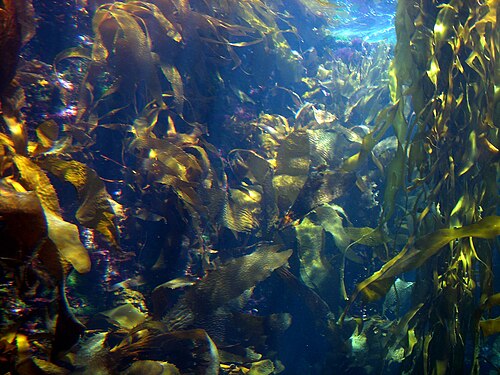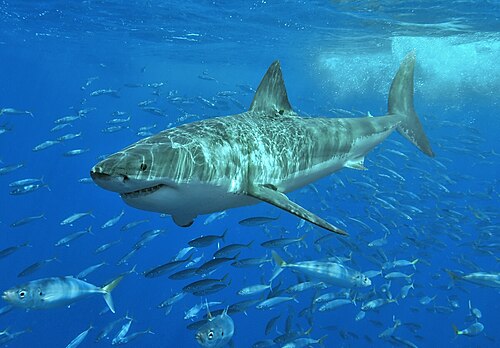High School Earth Science/Ocean Life
The ocean covers an area of about 361 million square kilometers, about 71% of the Earth. For that reason, it is a home to a large portion of all life on Earth. The life in the ocean includes many different species. Some species seem bizarre, others are enormous, some are delicious to eat, and others are dangerous. Living organisms can be found throughout the ocean, even in the most remote and harsh parts.
Lesson Objectives[edit | edit source]
- Describe the different types of ocean organisms.
- Describe the interactions among different ocean organisms.
Types of Ocean Organisms[edit | edit source]
There is a great variety of ocean life that ranges from the smallest animals on Earth to the largest. Some of these organisms breathe air from the atmosphere, while others can extract oxygen from the water. There are those that mostly float on the surface and those found in the ocean's depths. Some animals eat other organisms, while other creatures generate food from sunlight. The abundance of life in the oceans can seem endless. However pollution, acidification of the oceans, and overfishing can greatly reduce the diversity and abundance of ocean life. By studying and understanding the creatures of the ocean, humans can better preserve these organisms. With this in mind, we'll learn about the life forms in the ocean by dividing them into seven basic groups.
Plankton[edit | edit source]

The most abundant life forms in the ocean are plankton; most are so small that you can't even see them (Figure 14.27). These include many types of algae, copepods, and jellyfish. Because exploring the oceans is much harder than studying the land, many marine organisms haven't been extensively studied by humans. Scientists believe many species of marine organisms haven't even been discovered yet. The plankton are one group of organisms that have been studied extensively. The word "plankton", which comes from the Greek for wanderer, describes how these organisms live. All plankton float freely or drift, wandering at the ocean's surface.
The first link in all marine food chains are the phytoplankton, or 'plant' plankton, which use sunlight to make sugars from carbon dioxide and water (photosynthesis). Because they need sunlight, they can only live in the photic zone. Through photosynthesis, phytoplankton make food for themselves and give off oxygen, which is a waste product for them but essential for all animals on Earth. Phytoplankton produce all the food at the bottom of the ocean food chain, so they are called primary producers. Most of the photosynthesis on Earth happens in the oceans and phytoplankton produce a large share of the oxygen in the air we breathe. Zooplankton, or animal plankton eat phytoplankton as their source of food. They can be found in all parts of the ocean.
Plants and Algae[edit | edit source]
There are only a few true plants in the oceans; these include salt marsh grasses and mangrove trees. But large algae, or seaweed, also use photosynthesis to make food, just as plants do on land. These organisms have to live in the photic zone, because they require sunlight for photosynthesis. For that reason, most plants, seaweeds and algae in the ocean are found near the ocean surface or close to the shore. The large algae kelp grows in the neritic zone (Figure 14.28). Kelp tends to grow in forests, and can reach over 50 meters long. Kelp forests sustain an abundance of life, like the otter that lives in their swaying stems. It is thought that land plants adapted from ocean organisms some 500 million years ago.

Marine Invertebrates[edit | edit source]
The ocean includes a great variety of animals. One major group of animals is the invertebrates. Invertebrates are animals with no spinal column. Marine invertebrates include sea slugs, sea anemones, starfish, octopi, clams, sponges, sea worms, crabs and lobsters. Most of these animals are found close to the shore, but they can be found throughout the ocean. In fact, scientists were amazed to discover invertebrates that thrived in the deep ocean near hydrothermal (hot water) vents, including giant tube worms, crabs, and shrimps (Figure 14.29).

Fish[edit | edit source]
Like us, fish are vertebrates that have a spinal column and a hard skull. They are animals that have adapted to life in the water. Most fish are "cold-blooded" animals that have fins with which to move and steer, scales that protect them, gills with which to extract oxygen from the water, and a swim bladder that lets them float at particular depths within the ocean. Included among the fish are sardines, salmon, and eels, as well as the sharks and rays (which lack swim bladders) (Figure 14.30).

Reptiles[edit | edit source]
Reptiles are air-breathing, "cold-blooded" vertebrates. A few groups of reptiles have adapted to life at sea. These include sea turtles, sea snakes, a few saltwater crocodiles, and the marine iguana, which is found only at the Galapagos Islands (Figure 14.31). Most sea snakes bear live young in the ocean and do not need to come on land to breed. But turtles, crocodiles, and marine iguanas all lay their eggs on land, which makes both eggs and adults vulnerable to predation. For example, people use sea turtles or their eggs for food, for their shells, and for the medicinal purposes that some cultures believe they possess. Sea turtles are endangered species, so they are protected in many countries around the world.

Seabirds[edit | edit source]

Everybody loves penguins, a type of bird adapted to the sea (Figure 14.32). They do not fly; rather they are adapted to swimming and may spend half of their time at sea looking for food. There are many other kinds of seabirds, though, like gulls, gannets, pelicans, and petrels. Seabirds are adapted to catching fish by diving or by grabbing them at the surface with their claws.
Marine Mammals[edit | edit source]
Mammals are warm-blooded vertebrates that feed their young with milk. Most mammals have hair, ears, a jaw bone with teeth, and give birth to developed young. There are five types of marine mammals. The first type is termed Cetaceans which include whales, dolphins, and porpoises. The second type is called Sirenians which include the manatee and the dugong. Seals, sea lions, and walruses comprise the Pinniped group. Sea otters are the ocean members of the fourth group, the Mustelids, which also includes skunks, badgers and weasels (Figure 14.33). The final type of ocean marine mammal is the polar bear, which depends heavily on the ocean for survival and is adapted to a life around the sea.

Interactions Among Ocean Organisms[edit | edit source]
To best understand how ocean organisms interact, it is necessary to consider the particular environments in which they live. There are four main ocean habitats: the intertidal zone and shore, reefs, the open ocean, and the deep sea including trenches. Most organisms have some adaptations specific to their preferred habitat.
A great abundance of life can be found in the intertidal zone. Many intertidal animals can live in or out of the water; some spend one part of their lives in the water and another out of the water. They must be adapted to frequent shifting of water levels and wave impacts. In response, many have hard shells and strong attachments that keep them safe. Some animals, like marine mussels, cling steadily to a rock for their entire lives (Figure 14.34). Many young organisms get their start in estuaries, which are special ecosystems affected by the tides, where freshwater and salt water come together.

Reefs are built up by corals and other animals that deposit the mineral calcium carbonate to make rock formations near the shore. They support a complex ecosystem of ocean organisms that live within the coral reef. These diverse organisms have complex interactions with one another; some species help each other to survive. When reefs are destroyed or polluted, certain species can be affected more than others. Harm to one species may have a domino effect on other species. This may cause the entire ecosystem to collapse. Coral reefs are particularly sensitive to certain threats like temperature change and oil spills.
The open ocean refers to the large open expanses of ocean water. This vast area is the primary habitat for relatively few animals. Most of the food in the ocean is found nearer to shore, so most of these animals are just passing through. Some larger animals like whales and giant groupers may live their entire lives in the open water.
As you know, scientists were surprised to find life in ocean trenches, the deepest parts of the ocean. How can animals survive at that depth? They have adapted to the resources available there, and some bacteria can even use inorganic compounds as energy sources instead of relying on the sun as a source of energy. This is called chemosynthesis. Shrimp, clams, fish, and giant tube worms have been found in these extreme places.
Still other animals can live on floating rafts of algae or in frozen places, like the North and South Poles. No matter where you might look in the grand ocean, some creature has found a way to live there. Almost all of these creatures depend on each other. Certainly all creatures depend on producers that convert sunlight into biomass. Our oceans are currently threatened by global warming, overuse and pollution. These imbalances in the ecosystems may someday devastate the delicate web of life on which humans depend.
Lesson Summary[edit | edit source]
- Our oceans are home to a tremendous diversity of life including the very smallest bacteria to the very largest baleen whale.
- Some marine organisms float at the surface using the sun's energy, some exist at great ocean depths transforming chemicals in the water into food.
- Plankton are freely floating organisms that include the photosynthetic phytoplankton as well as the animals that eat them, the zooplankton.
- Virtually every phyla on Earth is represented in the ocean including invertebrate and vertebrate organisms, fish, reptiles, seabirds and even air breathing mammals.
- Many creatures in the ocean live in cooperation with other organisms, like coral animals that live symbiotically with dinoflagellates in their tissues.
Review Questions[edit | edit source]
- What are seven categories of life in the ocean?
- What does "invertebrate" mean?
- What group of organisms are the primary producers in the ocean, on which all other life depends?
- If fish require oxygen to live, why can't they survive on land?
- Some people argue that polar bears are not really marine mammals because they don't live in the ocean itself. They would say polar bears are land animals like all other bears. What is your opinion? Explain.
- What are four major habitats of ocean organisms?
- Describe adaptations that an organism that lives in a reef might have. How might these adaptations be different from an organism that lives in the open ocean?
- Describe the importance of maintaining the ecosystem in the ocean.
Vocabulary[edit | edit source]
- chemosynthesis
- Using inorganic compounds to produce food.
- invertebrates
- Animals with no spinal column.
- phytoplankton
- Plankton that can photosynthesize and therefore create oxygen and sugars.
- plankton
- A diverse group of tiny animals and plants that freely drift in the water.
- reef
- A large underwater structure created from the calcium carbonate skeletons of coral.
- vertebrates
- Animals with a spinal column.
- zooplankton
- Plankton that are tiny animals; they usually consume phytoplankton or other zooplankton as food.
Points to Consider[edit | edit source]
- How does the ocean interact with the atmosphere?
- How is energy transferred around the planet and how does this affect life on Earth?
- What does global warming mean for the oceans and how might this affect the entire globe?